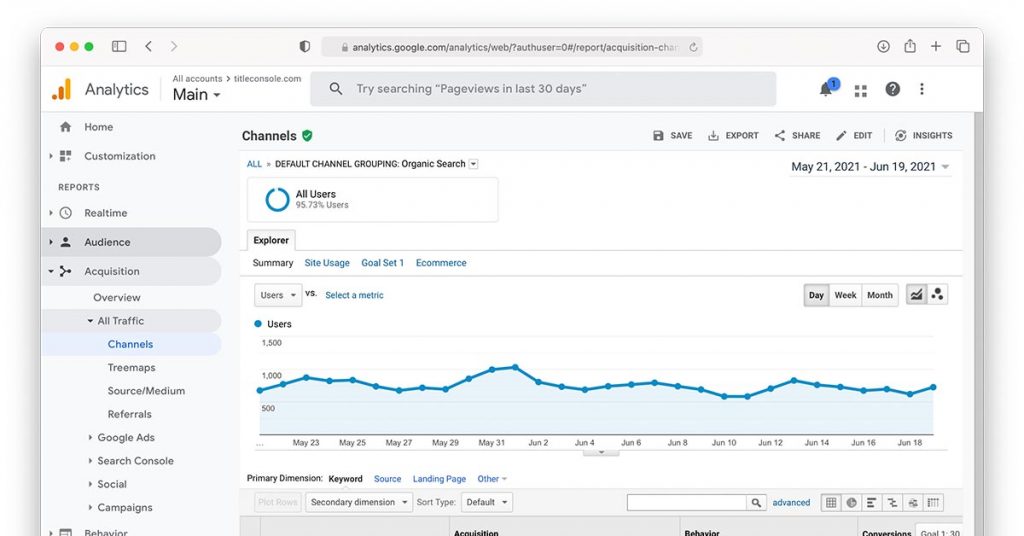Google Analytics (GA) is an invaluable SEO tool for tracking loads of data regarding website performance. What’s more, it separates the blog traffic by source, such as organic, paid search, direct, referral, and social, for easy monitoring and better insights.
In this article, we will show you how to track organic traffic in GA.
Let’s start by clarifying one thing. Just because Google Analytics is Google’s tool, it doesn’t mean you’re limited to tracking organic traffic from Google. It recognizes other popular search engines, including Bing, Yahoo, and Baidu.
Without further ado, here’s how to check organic traffic in Google Analytics.
Step 1: Sign in to your GA account.
Step 2: On the left-hand side of your GA account, you will see reporting options ( Real-Time, Audience, Acquisition, Behavior, and Conversions).Click on the ‘ Acquisition’ report tab to expand the menu.
Step 3: From the drop-down menu, select the ‘Overview’ option. A page will appear, displaying the traffic sources to your site: organic, social, referral, direct, email, paid search, display, affiliate, and more.
Step 4: Navigate to the top right corner of the screen andadjust the date range to your specific data tracking requirements. You can set a time frame range for organic traffic data comparisons between periods. For instance, you can choose custom, monthly, or yearly tracking.
Step 5: Select the ‘Organic Traffic’ option to explore the details. The next page will display a table with granular data. Well, this includes keywords (search terms and phrases that led visitors to your site), landing page (URLs your visitors entered the website on), and source (search engines that sent traffic to your blog).
Step 6: To check the performance of landing pages, select ‘Landing Page’ as your Primary Dimension. This tracking option is above the data table. Once on the landing reporting page, you’ll see the URLs that generate the most or least amount of traffic.
Alternatively, you can find the best performing blog titles, landing pages, or web pages by following these steps:
· Go to Behavior > Site Content > All Pages.
· Click ‘Page Title’ as your Primary Dimension.
· Change the date, and you’ll see the difference in page views by URL.
Please note you may not find some of the organic data metrics in the main data table mentioned above. You will need to link GA with Google Search Console (GSC) for additional insights. GSC will give you access to tons of other more specific information, including:
· Clicks – With Search Console, you’ll know the total number of clicks each blog post received.
· Impressions – Some web pages may not be driving the desired organic traffic, but they demonstrate a high impression rate. Such posts will need a little SEO work to send you more traffic.
· CTR – The click-through rate is a percentage of clicks that your page receives divided by the number of times the page gets shown in Google SERPs.
· Average position – The GSC report shows how the URLs from your blog rank in the search results. Positions are based on different search queries.
Understanding the Metrics and Dimensions in Google Analytics
These two types of elements will be present in every GA report. So, we like to talk about them briefly.
· Dimensions -They are distinctive attributes or aspects of your organic traffic data. You can call them categorical variables. Examples of dimensions you will see in GA include city, page, browser, and device.
· Metrics – Metrics deal with data that can be put in numbers. Some of the GA metrics include sessions, page views, pages/session, bounce rate, and conversions.
Wrapping Up
Whether you’re just getting started with blogging or are an SEO professional, Google Analytics can be a game-changer in your business. It provides you with substantiative and meaningful data that tells you what is and isn’t working and why. That way, you can make accurate adjustments to your SEO strategy and generate more leads to grow your business.
The available data tracking options can be overwhelming. But once you understand how to check organic traffic in Google Analytics, things will be a lot easier. You will also gain more valuable insights into other complex aspects, thus putting yourself in a better position to make more informed decisions.
References
https://blog.hubspot.com/marketing/google-analytics
https://support.google.com/analytics/answer/1033861?hl=en#zippy=%2Cin-this-article



